
THE FACIT BRANCH: ROCHDALE TO BACUP ROCH VIADUCT - HEALEY DELL VIADUCT - SIAMESE BRIDGES HEALEY DELL VIADUCT (SD880159) Whereas Roch Viaduct was of brick, Healey Dell is built of rock-faced gritstone from local quarries and is carefully snecked (i.e. the courses are frequently interrupted by smaller stones). Its particularly grace results from its narrowness, as it was built only for a single track; its considerable height, rising to 105ft above the River Spodden; and the narrow, tapering piers. There are eight 30ft round-headed arches, and three of them are acutely skewed, these being the arch over the river and the two either side. Biddle notes that the voussoirs* are squared, and equal care was given to the snecking of the tooled soffit** stones and the sharp arrisses***. Even the stone corbels that supported the wooden centering during construction have concave mouldings. Dell Road, to the south, is crossed by a less attractive iron plate girder span. It is estimated that 5,700 cu yd of masonry were built into the viaduct and timber scaffolding used during its construction amounted to 3,500 cu ft. Construction of the Healey Dell Viaduct, unlike the Roch Viaduct, appears to have been free from major incidents. The gradient of the viaduct falls southward at 1 in 60. Healey Dell Viaduct handled goods and passenger trains until the latter were suspended on 16 June 1947, and the line across it closed entirely on 21 August 1967; the tracks were lifted by the end of that year. The survival of the viaduct is due in part to its important, but covert, role in carrying a sewer across the valley. However it now also conveys a traffic-free cycle route over the valley as part of the delightful Healey Dell Nature Trail which was established in 1972. 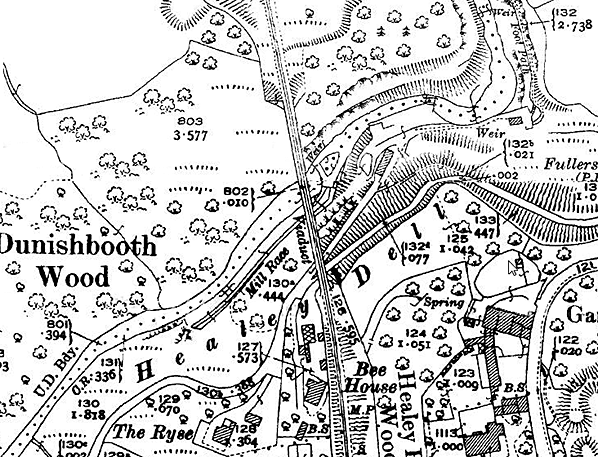
1929 1:2,500 OS map. Healey Dell Viaduct is between Shawclough & Healey station (south) and Broadley (north) and it carries the Facit Branch over the River Spodden at a point where the valley is particularly narrow. The viaduct is 90yd in length and rises 105ft above the river bed. The Mill Race, seen on one of the accompanying photographs, is parallel to the river. In World War 2 an explosives factory was built in the valley north-east of the viaduct and associated sidings were constructed east of the railway; soon after the war the factory closed and the sidings were removed. Although the railway tracks across the viaduct was removed in 1967 the structure survives as a footpath – the highlight of the Healey Dell Nature Trail.
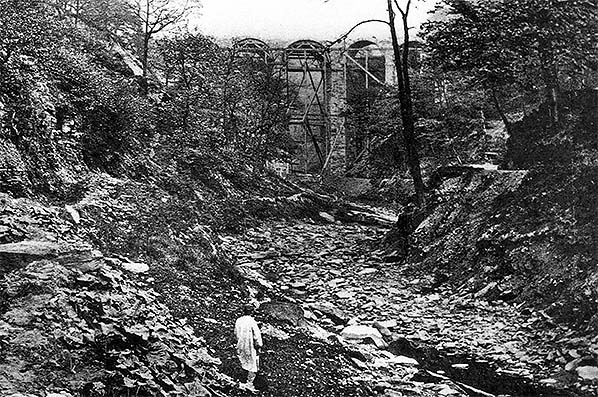
Healey Dell Viaduct is seen under construction c1866, looking south-west. The arches appear to be complete, but the timber frame beneath the crown of two arches and the scaffolding are still in place and the superstructure remains to be added. The photograph is likely to have been taken on a Sunday when building work would be laid aside in observance of the Sabbath, as a navvy in his cap and smock has time to stand by the rocky bed of the River Spodden and contemplate the fine building that he has been helping to construct.
Eric Bollington and Jeffrey Wells collections 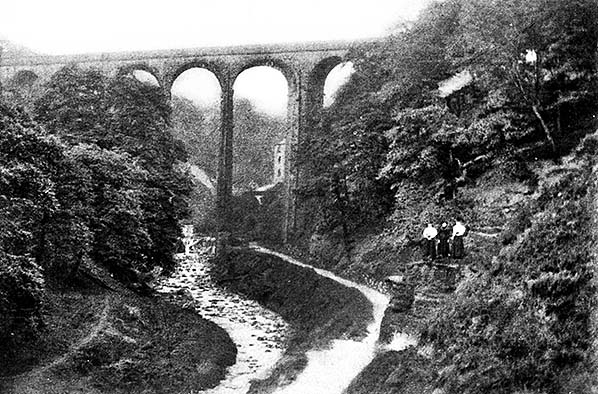 Healey Dell Viaduct, a quarter of a mile south of Broadley station, looking north-east c1890. The Dell provided an opportunity to take refuge from the industrialised landscape of the Whitworth Valley, offering a picturesque, secluded walk beside the River Spodden with its waterfalls. Three smartly-dressed women are admiring the scenery from a rocky vantage point. The graceful arches of the viaduct added to the delight of this spot, as they still do today. Healey Mill, in the distance beyond the viaduct, has long been demolished.
Photo by Sergeant Morgan courtesy of Bacup Library 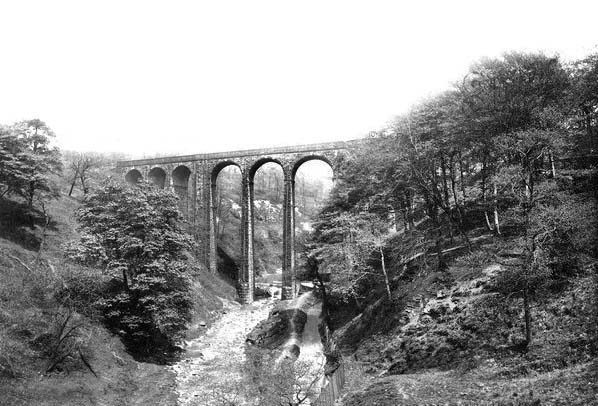
Healey Dell Viaduct looking north-east in 1898.
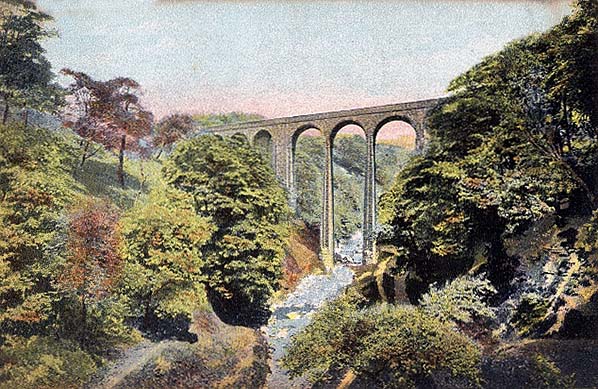
An early twentieth century tinted view of Healey Dell Viaduct, looking north-east. The dell is a delightful, tranquil spot within easy reach of Rochdale and the industrial villages of the Whitworth Valley. Not surprisingly it was, and still is, a popular location for country walks.
Photo from John Mann collection 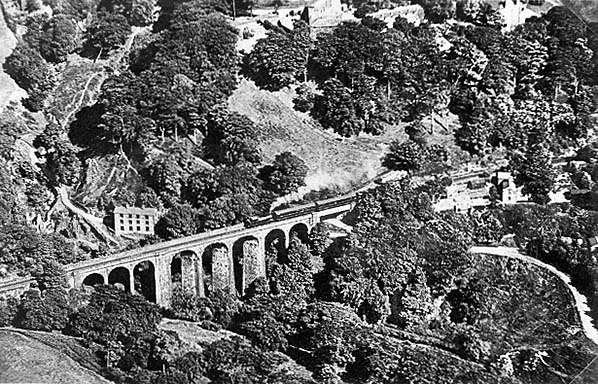 A view of Healey Dell Viaduct, looking south-east c1928-30, with a passenger train travelling northwards, bunker-first. Dell Road can be seen to the right and Healey Mill is on the valley floor beyond the viaduct. The loco is a LYR 2-4-2T. The coach coupled to it is an LYR corridor brake of a design introduced in 1906. This stock was built for long distance main line services, including through working onto other companies tracks. After the Grouping in 1923, the LMS dispersed this stock elsewhere; most, but not all, ended up in Scotland.
Photo by NS Roberts from John Mann collection 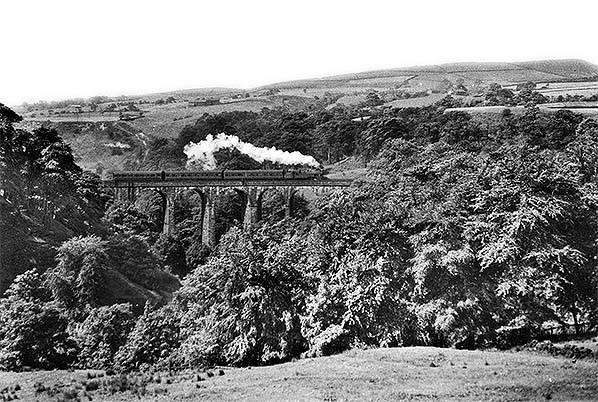
Photos of passenger trains active on the Facit Branch in the LMS era are scarce. On this view of Healey Dell Viaduct No.194 is hauling its train northbound in June 1947, the month in which passenger services were suspended, never to be resumed. LMS No.194 is a Stanier 2-6-2T, classified 3P, meaning Class 3 Passenger. Bacup shed had a small allocation of these locomotives for use on the line; when passenger services finished they were moved away, largely to Southport.Withdrawals began quite early and the class became extinct during 1962 and none survived. No.194 became BR No.40194 and lasted until October 1961 when withdrawn from 27C, Southport shed. In July 1962 she was cut up by the Central Wagon Co, Ince, Wigan. The brake-third being in the middle of the train is rather odd and suggests that the train had been strengthened by the addition of another carriage, so perhaps it was market day at Rochdale or Bacup. The same train was photographed by
W A Camwell at Britannia station. Photo
by W A Camwell
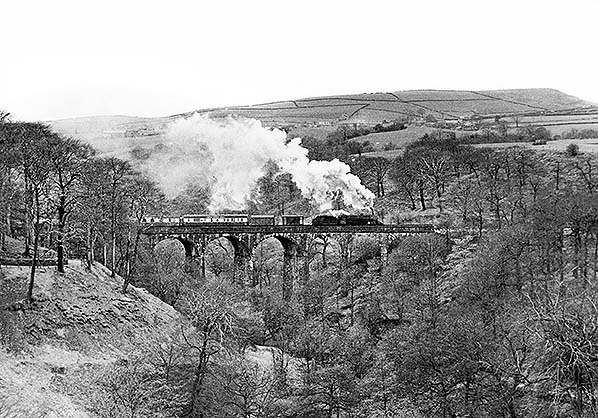
On 30 April 1963 a weedkilling train is travelling north over Healey Dell Viaduct. Hauling the train is No. 42750, a Hughes-designed ‘Crab’ 2-6-0 built in June 1927 at the LMS Crewe works. In August 1963 she was withdrawn from 39A, Gorton shed, to be cut up at Wards, Broughton Lane, Sheffield, in May 1964.
Photo by Richard S Greenwood 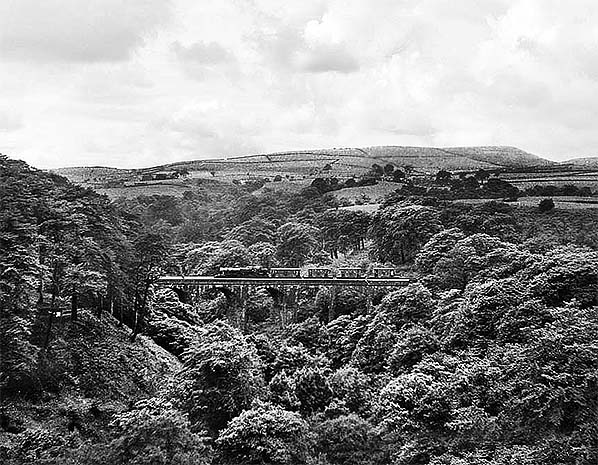 The LCGB ‘Middleton Branch Brakevan Tour’ is seen from the east crossing Healey Dell Viaduct on 7 August 1965. This train consisted of nine brake vans but on its northbound journey it stalled on the 1 in 59/62 gradient north of Wardleworth, and the loco propelled its load back to Wardleworth where five of the vans were detached. The four remaining vans completed the journey to Whitworth and back to Wardleworth, where the train was re-formed to the full nine vans. The LCGB ‘Middleton Branch Brakevan Tour’ is seen from the east crossing Healey Dell Viaduct on 7 August 1965. This train consisted of nine brake vans but on its northbound journey it stalled on the 1 in 59/62 gradient north of Wardleworth, and the loco propelled its load back to Wardleworth where five of the vans were detached. The four remaining vans completed the journey to Whitworth and back to Wardleworth, where the train was re-formed to the full nine vans.Photo by Barry Hilton Click here for more pictures of Healey Dell Viaduct
|
 Home Page
Home Page